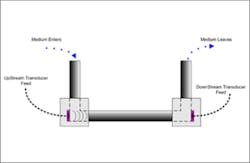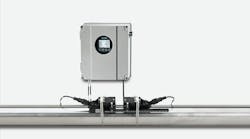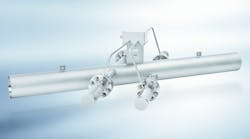While there are not many applications for measuring extremely slow flowrates, several of them are critical to the environment. One of the most important is tracking contaminants in groundwater. There are many sources of potential contamination—fertilizer run off, oil leakage, spills, coastal landfill seepage, and a variety of chemical intrusions—and the Environmental Protection Agency (EPA, www.epa.gov) mandates constant monitoring of groundwater where such contamination has occurred.
One company that offers these and other services is Coastal Monitoring Associates (www.coastalmonitoringassociates.com) based in San Diego, Calif. The company is comprised of a team of engineers, scientists, and technicians who have developed new technologies for the monitoring and characterization of groundwater/surface water interaction. These technologies include rapid, direct-push, multi-probe mapping systems, as well as continuous-detection ultrasonic seepage meters with flow-proportional water sampling. The company’s services are used in assessment of coastal landfills and hazardous waste sites, contaminated sediment management, validation of sediment capping systems, and water management investigations.
Groundwater Seepage Measurement
One of CMA’s biggest successes is its patented methodology for ultrasonic offshore monitoring of contaminated groundwater seepage.
“When there’s groundwater flowing that’s discharging offshore, our clients often want to know the amount, or the flux, and how that would be passing through the sediment into the surface water,” said Ron Paulsen, hydrologist for CMA. “They often have to design a cap for these sediments to assure the contaminants do not seep into the surface water. To design the cap you have to know the force that affects the flux that goes through the sediment. That helps them to determine the thickness and porosity of the cap.
The seepage technology utilized by CMA is based on the transit-time ultrasonic groundwater seepage meter. Three types of ultrasonic seepage meters are utilized depending on the requirements of the study—either the Ultra Seep (US), the Ultrasonic Buoy System (BS), and the Ultrasonic Submerged Flow-Only System (SFO). All three systems rely on the same principle and underlying hardware to detect seepage but provide different configurations for deployment. The U.S. system integrates the ultrasonic seepage meter system with a flow-proportional water sampling system. The BS and SFO systems are identical in theory of operation, but only measure the flow (no automated water sampling), and the BS battery and data logger are mounted remotely in a buoy, which can support up to two seepage meters. A complete description of each meter technology can be found in the Groundwater Journal in articles by Paulsen, et al., and Chadwick, et al. (2003).
“We basically adapt a flowmeter to an underwater housing and deploy it just offshore,” said Paulsen. “We direct the groundwater through a funneling system that we implant in the sediment bottom.” From the funnels it’s piped through an underwater housing that has the flowmeter in it, which enables the accurate measurement of seepage flow, which can in turn be provided to clients.
Identifying a Flowmeter
“Ultrasonic seepage data for the US, SFO, and BS meters are processed to determine specific discharge rates,” said Paulsen. “Data from the three meter types are processed in essentially the same way. Raw data from the meter are recorded as a flowrate, generally in units of L/min.” These flow data are converted to specific discharge based on the geometry of the flow tube and seepage funnel as where Q is the flowrate measured by the ultrasonic flowmeter, and Af is the area of the funnel. “We have resolved the specific discharge down to 0.25 cm per day using a larger funnels capture area,” said Paulsen.
Central to this technique is the ultrasonic flowmeter. Since the flows are very modest—down to 5 milliliters per minute; to visualize just how modest that flowrate is, consider that a milliliter of water contains approximately 20 drops. If the water was coming out of a small tube at that rate, it would be flowing at about one drop per second. So it was critical to the whole operation to have an extremely sensitive and accurate flowmeter.
“When we did our research we found only one manufacturer who could measure low flows accurately,” said Paulsen. “Controlotron offered a meter called the Flow Tube that was ideal for our operation.”
The Contolotron meter consists of a U-tube with a small down pipe positioned in a bored out plastic block, a cross pipe in another block, and another plastic block containing an up pipe. The metering method used time-of-flight ultrasonic technology to measure these very slow flow velocities and compute a volumetric flowrate. The two plastic blocks have an embedded piezo crystal in them that looked down the long pipe in the middle and measured slow flows accurately.
The Search Begins Again
The whole system worked very well until Siemens acquired Controlotron and decided to discontinue the meter. CMA was left without a supplier and therefore faced the possible loss of a significant part of their business.
Fortunately, there was a potential solution. Peter Chirivas had been an engineer at Controlotron and had worked closely with CMA for 10 years. He had recently moved to another ultrasonic meter manufacturer, Flexim Americas. Since Chirivas had intimate knowledge of CMA’s needs, the company asked him if his new company could provide a solution.
“It was a really interesting challenge,” said Chirivas. “No one at Flexim had ever thought about measuring such slow flows.” Flexim had developed the capability to measure gasses, liquids, slurries, and all of them at a wide range of temperatures, but it had never tried extra slow flows. “Ron and I worked on the challenge after hours,” said Chirvas. “Coastal’s need was clear, and we wanted to be of help. To our surprise one of our existing meters really did well.”
“What we did was mount transducers on the outside of a straight pipe,” said Chirvas “We then induced an ultrasound beam that bounces back and forth inside the pipe as many as 20 times or so. Our time in the liquid is a long as the old U-tube technology without having to look down the pipe.” The meter had clamps on the outside of the pipe with a beam transmitting diagonally across it. Instead of going across it once or twice, it crossed 18 and 24 times.
The meter provided the necessary accuracy due to an unusual transducer mounting configuration, based on a half-inch thin wall stainless steel tube that was treated with Flexim’s proprietary sound deadening material, which enabled the meter to sustain between 18 and 24 passes. The path length becomes comparable to the old Controlotron meter, and you end up with an extremely sensitive and repeatable flow of data. The repeatable data is in the area of 5 percent accuracies at these very low flowrates. As the data gets richer, the repeatabity decreases to between 1 percent and 2 percent. The nice thing about being a straight-through flow is that you get no pressure drop because basically it’s just a pipe. There are no bends, nothing to clog, nothing to get dirty.
“In this context, our extremely tight and stable zeroes come into play,” said Chirvas. “With the previous technology, the zero tended to drift and needed to be corrected over temperature and time. With our new configuration, the meter has a much more stable zero.”
“The new Flexim system gives us a more stable system than we had,” said Paulsen. “And the accuracy has been excellent.” The final configuration is still being developed, but CMA is confident the system will provide a stable and accurate platform.
Jack Sine is a freelance writer specializing in environmental issues and the chemical, power, and HVACR industries. He can be reached at [email protected] or by phone at 845-831-6578.




